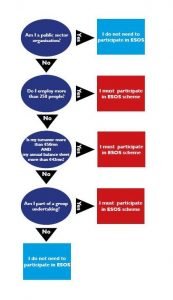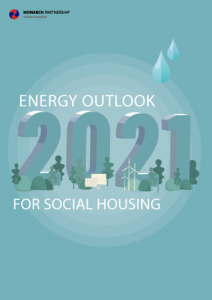UPDATE Note on 2 February 2016: If you missed the 5 December 2015 deadline, see for Environment Agency’s instructions.
Contact us and we will arrange a Lead Assessor to help your organisation with the ESOS compliance.
ESOS – Do you qualify?
In the November Energy Update 2015 issue you learn more about the ESOS scheme, does it affect you and what it means to your business. Check the ESOS scheme criteria below if you qualify or not. below

The Energy Savings Opportunity Scheme (ESOS) is a mandatory energy assessment scheme for organisations in the UK that meet certain criteria. ESOS is estimated to impact nearly 10,000 organisations overall, accounting for around a third of total UK energy consumption. Its intent is to encourage large organisations to save energy and to reduce their operating costs.
Download our guide to ESOS
(UPDATE) Large numbers of businesses did not meet the deadline. Research has suggested that companies would have to submit their audits at a rate of more than 80 per day until December, if all eligible firms were to be compliant by the cut-off date.
Recommended reading:
Our ESOS smart guide topics include:
What is ESOS?
ESOS, The Energy Savings Opportunity Scheme is a mandatory energy assessment scheme for organisations in the UK that meet certain criteria. ESOS is estimated to impact nearly 10,000 organisations overall, accounting for around a third of total UK energy consumption. Its intent is to encourage large organisations to save energy and to reduce their operating costs.
The scheme achieves this by providing an incentive for businesses to identify cost-effective energy efficiency measures covering their buildings, industrial processes and transport.
The government estimates that, overall ESOS will see firms facing assessment costs of £165mn, administration costs of £235 mn, and the capital and inconvenience costs of implementing the energy efficiency measures identified (estimated at £750 mn). But the government believes that the scheme will result in savings of around £1.6 bn by 2030.
ESOS is part of the UK’s approach to meeting the requirements of the EU Energy Efficiency Directive, which came into effect in December 2012. The Directive is one of the main mechanisms for reaching the EU target of a 20% reduction in energy use by 2020.
Who Will It Affect?
You can quickly see from the ESOS criteria figure if you qualify for it or not.
An organisation will qualify for ESOS if, on 31 December 2014 (or in the 12 months immediately preceding this), it meets the ESOS definition of a “large undertaking”. This is defined as an organisation that:
- has 250 employees or more; OR
- has less than 250 employees but has an annual turnover exceeding €50 mn / approximately £41 mn and an annual balance sheet exceeding €43 mn (around £35 mn).
Organisations that are part of a corporate group, including an undertaking meeting the above criteria, will also be required to participate. The scheme will mainly affect businesses but can also apply to not-for-profit bodies and any other non-public sector undertakings that are large enough to meet the qualification criteria.
Examples of undertakings that can qualify for ESOS include:
- limited companies
- public companies
- trusts
- partnerships;
- private equity companies or limited liability partnerships
- unincorporated associations
- not-for-profit bodies*
- universities that get more than half their funding from private sources
*Please note that most larger charities will be a corporate body and as such are considered to be an undertaking.
To find out if you qualify, take your employee numbers, turnover and balance sheet totals in the 12 months immediately preceding the qualification date of 31 December 2014.
Public sector organisations will be exempt from ESOS as they must instead comply with separate government procurement rules. ESOS also does not apply if an undertaking is subject to an insolvency procedure.
If you have an ISO 50001 energy management system that is certified by an accredited certification body and covers all your energy use (for the whole corporate group in the UK), this also counts as your ESOS assessment.
Four Main Steps to Ensure ESOS Compliance
If you are required to participate in the ESOS scheme there are four main steps to ensure your compliance:
Step 1
The first step is to conduct an ESOS Assessment. This must take into account total energy consumption (including buildings, transport and industrial processes). To ensure measured consumption reflects an organisation’s assets at the time of qualification, the ESOS Assessment must cover a 12-month period, overlapping with the qualification date (for phase one of ESOS this would be 31 December 2014).
The ESOS Assessment data must:
- be for a continuous 12-month period;
- cover 100% of total energy consumption;
- begin no earlier than 6 December 2010 for the first compliance period;
- begin no more than 24 months before the start of the ESOS Audit; and
- not have been used as the basis for an energy audit in a previous compliance period.
Step 2
Next, organisations must use their ESOS Assessment to identify “areas of significant energy consumption”. These should cover 90% of total energy consumption. In each ESOS phase these areas must then be covered by an ESOS Audit (or by another compliance method).
Participants can choose not to identify the specific areas of significant consumption. However, in choosing to do so, ESOS requires that 100% of energy consumption is instead audited.
Step 3
One of the four ESOS compliance methods must be chosen in order to comply with ESOS. These are:
- An ESOS Audit
- ISO 50001 certification
- Display Energy Certificates (DECs) and accompanying advisory reports; or
- Green Deal Assessments
A mixture of compliance options can be used but all areas of significant energy consumption must be covered. If the ESOS Audit option is chosen, this must analyse energy consumption and energy efficiency using energy consumption profiling. This involves breaking down the different ways in which energy is used by a participant’s activities and assets and analysing any variations in energy use to identify inefficiencies. The Audit, which must be conducted by an accredited ESOS Lead Assessor, must identify reasonably practicable and cost-effective energy saving opportunities.
Calculating the cost of implementing a measure should be based on an analysis of whether the investment will be economical over its entire life. This would include taking into account the cost of purchase, installation, maintenance and depreciation. But there is no regulatory requirement for participants to implement the energy-saving opportunities identified.
Step 4
Upon completion of the ESOS Assessment, all participants are required to submit a notification to the Environment Agency, stating that they have complied with the requirements for ESOS. This notification must be sent on or before the compliance date of the phase. In the case of phase one of ESOS the compliance deadline is 5 December 2015.
Compliance will be reported via an online notification system. To bring awareness to the top level of the organisation of the compliance requirements for ESOS, and also of any energy-saving opportunities that may have been highlighted, the ESOS Assessment must be signed-off by a company director or equivalent senior manager. If an in-house Lead Assessor has been used to conduct, oversee or verify assessments, two directors or equivalent senior managers must sign-off on the ESOS assessment, to provide additional verification as to the independence and quality of the report.
Participants in ESOS are also required to compile and maintain an ESOS Evidence Pack detailing various aspects of their compliance with ESOS. The ESOS Evidence pack should include the following:
- details of the organisational structure of the participant;
- details of the board level director(s) or equivalent who have taken the lead on signing off ESOS Audits;
- details of the Lead Assessor, and the approved register they are part of;
- the calculation of the total energy consumption;
- a list of the areas of significant energy consumption; and
- details of the compliance method(s) used to cover each area of significant energy consumption.
More details on the ESOS compliance are available from the Environment Agency.
Non-compliance
The Environment Agency has said it will take a “light touch” to non-compliance; however, failure to undertake an ESOS Assessment incurs a penalty of up to £50,000 and an additional £500 per day per site (up to a maximum of 80 days). Other compliance issues also bear lighter penalties and non-compliant organisations will be publicly listed, leading to a threat of reputational damage.
Progress of ESOS Scheme
The Environment Agency revealed to BusinessGreen that as of 14 August only around 120 businesses are fully ESOS compliant out of an estimated 14,000 UK organisations that fall under the scheme’s criteria.
ESOS project manager Jo Scully said: “We know from experience of administering more established schemes that notifying the administrator is often done very close to the deadline. We are aware that many businesses are currently undertaking the relevant tasks to complete their ESOS assessments, and as such anticipate that the number of notifications will start to rise more significantly as we approach the deadline.”
Key Dates
ESOS will run in four-year phases. Participants must assess whether they qualify for participation in ESOS on the qualification day of each phase – for the first phase this is the 31 December 2014.
The last day of the compliance phase is the deadline for ESOS Assessments, and notification of compliance – for the first phase this was 5 December 2015. This means that for the initial phase of ESOS, activities to support the ESOS Assessment (such as ESOS Audits, Green Deal Assessments etc.) must have been undertaken between 6 December 2011 and 5 December 2015 for the organisations to be considered compliant.
The second phase will run from 6 December 2015 to 5 December 2019, with the qualification date for the second phase being 31 December 2018. The third phase will run from 6 December 2019 to 5 December 2023, with the qualification date for the third phase being 31 December 2022.
To progress your ESOS compliance process, please contact us.
















